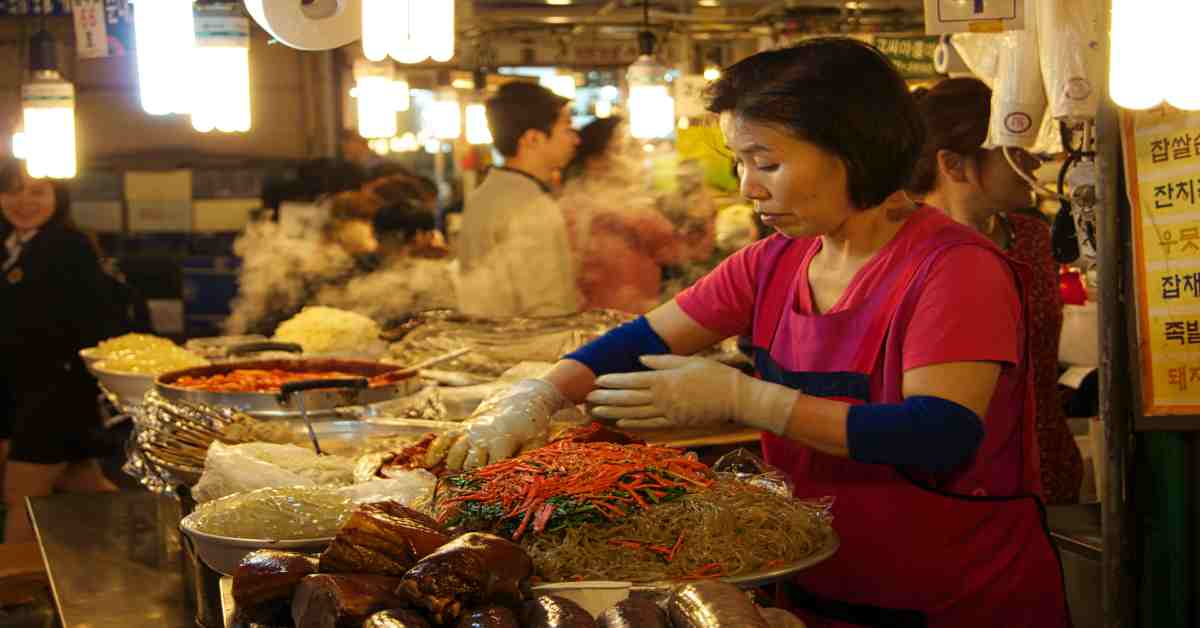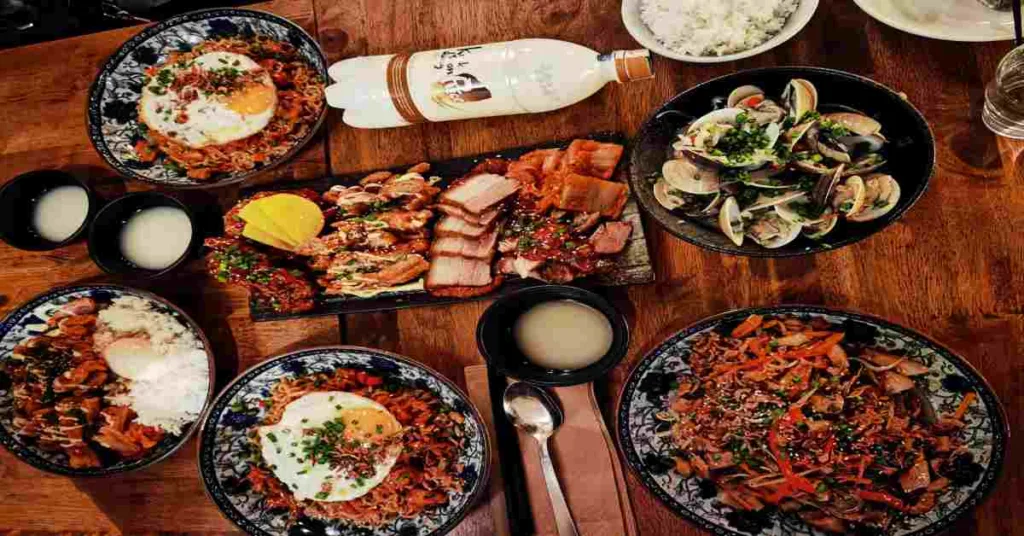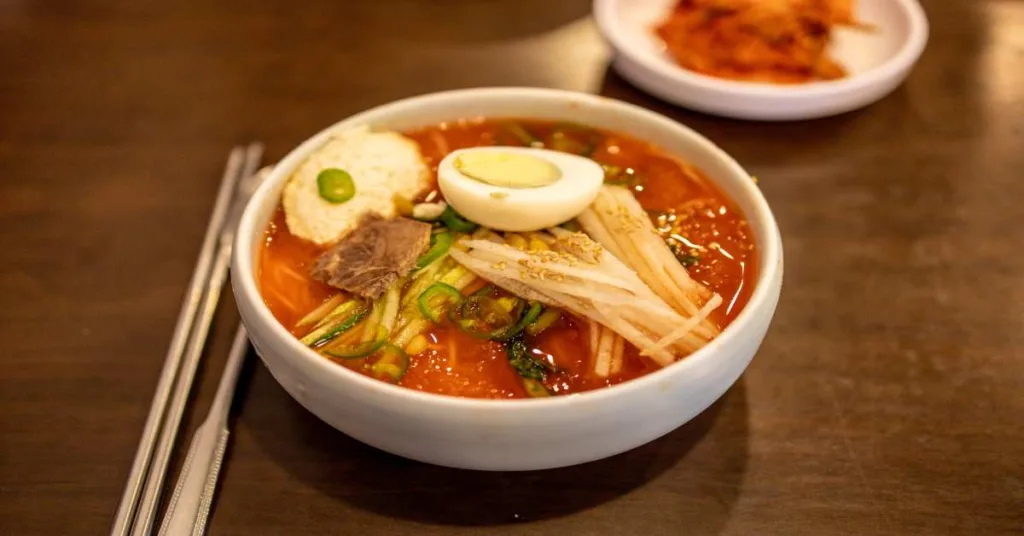Haemul Pajeon, or Korean scallion pancakes with seafood, are a Busan speciality. These pancakes are exceptionally crispy because two different types of flour are combined. With tangy soy dipping sauce, serve. Delicious!
Contents:
- What is Haemul Pajeon?
- Varieties of Jeon
- Difference between Jeon & Buchimgae
- Recipe
- How to serve & eat Pajeon?
- What to serve with Pajeon?
- What does Pajeon taste like?
- How to store and reheat Pajeon?
What is Haemul Pajeon?
A common Korean savoury pancake called Haemul pajeon is made with shrimp and scallions. In Korea, scallions are used to prepare a savoury pancake called pajeon. “Pa” means scallion in Korean, while “jeon” is a pan-fried, battered meal. When referring to the most popular variant, which is cooked with seafood, the term “Haemul pajeon” is used (Haemul). This savoury pancake, along with kimchi jeon, buchjeon, and nokdujeon, is one of Korea’s favourite appetisers or snacks.
The rainy season in Korea is associated with the month of July. When it rains, Koreans adore greasy, salty pancakes. When the weather is terrible, our bodies must have a craving for oily, fatty meals. It is thought that people crave Haemul pajeon when they hear the sound of rain because the sound of raindrops hitting a window or dropping to the ground is similar to the sound of sizzling when you prepare this savoury pancake.
These Korean seafood scallion pancakes, are also known as green onion pancakes or Haemul pajeon. Green onion/scallion is a key component in the Korean pancake type known as pajeon. As a result, it is translated as scallion pancakes or green onion pancakes. Scallions are usually what make Pajeon distinctive. Although it resembles a Chinese scallion pancake in appearance, it is created from a liquid batter, giving it a lighter feel than the Chinese dish (but still resembling Western pancakes).
In addition to green onions, other ingredients include water, an egg, homemade or store-bought Korean pancake mix, and frequently a mixture of seafood. Haemul Pajeon is a dish that all seafood lovers should include on their menus. This pancake has a crunchy exterior and is constructed from a batter of rice, eggs, various shellfish, and green onions. Shrimp, squid, oysters, and shellfish are among the more popular seafood products.
These will be a tremendous comfort when the weather makes you feel down. As you enjoy these pancakes, your stress from the day will go. Korean Rice Wine, or Makgeolli, is frequently served with the savoury Korean pancake dish. Despite tasting sweet, it is just as potent as alcohol. So, sip your beverage with care. It is also eaten with vinegar soy sauce. Seafood’s chewy texture and green onions’ crunchiness work together to enhance the taste as you chew.
Varieties of Jeon
Jeon is the name for the battered and fried varieties of Korean pancakes. Though you might only find a few options at Korean grocery shops, the world of Korean pancakes is far larger than that.
Hotteok-Filled pancake: This pastry is a common Korean dish that is made by stuffing a piece of dough with nuts and sugary cinnamon before frying it until it is fragrant and brown.
It is widely accepted that Chinese traders first introduced Hotteok to Korea in the late 19th century. The filling in the Korean version is different from that in the Chinese version. Koreans choose brown sugar, spices, and nuts instead of the Chinese who favour savoury meat filling.
Hwajeon- Sweet Rice Pancake: Hwajeon, often known as Korean flower pancakes, are exquisite. Hwajeon is a traditional Korean dish made by pressing edible flower petals onto small rice cakes during the Buddha’s Birthday.
Although there are numerous variations of Hwajeon that use various flowers, the rice cakes remain the same. They are a lovely option for sweet breakfast foods, which is quite practical.
Hobakjeon-Zucchini Pancake:
Hobak-jeon, which translates to “zucchini pancakes,” is the Korean word for squash or, in this case, zucchini. Hobakjeon, however, consists of battered and fried zucchini slices rather than a typical pancake. It is excellent as an appetiser, snack, or small dish made with zucchini.
Korean families typically consume Hobakjeon with white rice or a soy sauce-based dipping sauce. This meal is very popular throughout the summer, at New Year’s, and on Korean Thanksgiving.
Pajeon-Scallion Pancake: The Chinese scallion pancakes may be something you’ve heard of. Making a yeasted dough and a slurry of lard, flour, and scallions as the filling is required in the Chinese recipe. Scallion pancakes are prepared slightly differently in Korea.
The cook does not need to knead the dough until it is completely smooth for this Korean pajeon. Instead, they will prepare a savoury batter with a western pancake batter texture. You can prepare pajeon at home, a common fixture on Korean dinner tables.
Gamja Jeon-Potato Pancake: The Korean word for potato is “Gamja,” and “Gamja jeon” is a pancake prepared from grated or pureed potatoes.
Gamja jeon is often made just with potatoes, salt, and vegetable oil. For a superior texture, modern versions of this pancake now include other crunchy veggies, like carrots and onions. For the pancake to hold together while cooking, the grated vegetables are stacked into a circle and squeezed together. The thin potato patties are deep-fried in vegetable oil until they are crisp and brown on all sides. The typical side dish is choganjang, a dipping sauce composed of soy sauce and vinegar.
Haemul jeon-Seafood Pancake: Haemul Jeon can feature a variety of fresh seafood specialties, such as shrimp, mussels, squid, and more. The pancake becomes known as Haemul Pajeon when it has a considerable number of green onions.
Haemul jeon is frequently made by Korean households using Buchim Garu, a pre-mixed pancake mix. This helps you save time, especially if you need to feed a large family quickly. However, you can make your own pancake batter.
Haemul jeon uses fish to emphasize how close Korea is to the ocean.
Dongtaejeon-Pollock Pancake: In South Korea, pollock is less expensive than other fish options. Pollock pancakes are typically eaten with Bulgogi (Korean BBQ beef) and a popular Korean noodle dish called Japchae on special occasions in that country (Mixed cellophane noodles).
Dongtae refers to the frozen pollock fish and jeon to the preparation. Even though you can use fresh pollock fish to prepare this Korean pancake, frozen pollock is frequently easier to come by in South Korea.
With a flavorful dipping sauce, this Korean dish is fantastic. On the other hand, you may also have this pollock pancake with some lemon juice, along with a variety of other side dishes from Korea and white rice.
Difference between Jeon & Buchimgae
Buchimgae and Jeon, two varieties of savoury Korean pancakes, are often used interchangeably. But their cooking methods are what set them apart from one another.
- All of the ingredients for buchimgae are combined in a sizable mixing bowl, scooped out using a ladle, and then pan-fried.
- In order to maximise the flavour and texture of the individual ingredients, the ingredients for jeon are each individually coated with the flour mixture before being placed into the skillet separately.
Recipe
Ingredients: Korean pancake mix, rice flour, ice water, scallion, seafood(shrimp, squid, mussel), eggs, oil
For Soy dipping sauce: Soy sauce, vinegar, Korean chilli flakes, toasted sesame seeds, green onions.
STEP 1: Pancake mix and rice flour are combined in a mixing basin with icy water. Mix just enough to moisten the batter. To achieve the consistency of the western pancake batter, adjust the water amount.
STEP 2: A tablespoon of oil has been heated in a skillet over low heat. To fit the skillet, arrange the scallions. Make the pancakes no larger than 9 to 10 inches in diameter if the skillet is larger.
STEP 3: Just enough pancake batter should be drizzled to cover the scallion. Shake the skillet lightly to allow the pancake batter to seep into the bottom and support the green onions.
Step 4: If you’re using seafood, distribute the chunks over the scallion and pour the beaten eggs on top.
Step 5: Over medium heat, pan-fry the pancake for three to four minutes. Cook for a further three minutes after flipping to the other side. If the skillet appears to be dry, add a little extra oil. The crust should be crunchy and a deep shade of golden brown. In order to prevent burning the scallions, adjust the heat.
Step 6: Cut the pancakes into large, bite-sized pieces after placing them on a cutting board. Serve the pancakes with the soy dipping sauce right away.
Step 7: Combine and thoroughly mix all the ingredients to make the soy dipping sauce.
How to serve & eat Pajeon?
Pajeon is typically presented on a large dish in the shape of a circular pancake. Before eating, divide the huge pancake into many pieces. Eat one piece on a small individual plate with a spoonful of dipping sauce.
What to serve with Pajeon?
Korean Rice Wine, or Makgeolli, is frequently served with the savoury Korean pancake dish.
These dishes which go well with Pajeon like;
- Dipping sauce
- Asian Chicken Salad
- Soup
- Stir-fried Beef
- Fried Fish with Chilli Sauce
What does Pajeon taste like?
Seafood is really chewy, and it tastes and smells like fried green onions and toasted eggs. Everyone would enjoy it because you can taste the original ingredients used even if it isn’t as spicy or garlicky as another Korean cuisine.=
How to store and reheat Pajeon?
You may either cover pancakes in foil and put them in the fridge, or you can store them in an airtight container. Pancakes keep nicely in the refrigerator for a week. If you have a lot of pancakes, you can freeze the extras. Simply place them in a freezer-safe bag after carefully wrapping them in plastic wrap.
Put wax paper between each slice and store them in a Ziploc container. By doing this, the pancakes won’t attach to one another. Place them on a nonstick pan and reheat on all sides over low heat. This is the most effective approach to reheat pancakes while preserving their crunch.


